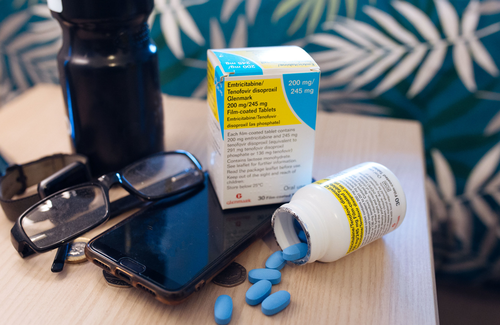
A meta-analysis of 59 studies of PrEP from all continents has found that 41% of people who started taking PrEP had discontinued it within six months.
Discontinuation rates were much higher in studies for all groups other than gay and bisexual men and trans women, including female sex workers, people who inject drugs, and at-risk heterosexuals. In studies of heterosexual men and women the six-month discontinuation rate was 72%.
On the other hand, in the minority of studies that continued to follow people after they stopped PrEP, 47% of people who were followed for more than a year eventually re-started it.
Background
Since the early days of PrEP availability in the US, we have known that, among gay and bisexual men at least, taking four or more doses of PrEP a week is sufficient to prevent HIV infection and that HIV infections are very rare in people who do keep up this level of adherence. We also know that event-driven PrEP is just as effective among gay and bisexual men who take it consistently before and after encounters that risk HIV.
However it has also become apparent that over the long term, over a scale of months to years, PrEP use is often episodic, with one US survey reporting that the average time users spent on it was a year and another finding that only 40% took it for longer than two years. The largest US study to date found that 52% of people who started PrEP between 2012 and 2019 stopped it for over four months at least once, though 60% later resumed it.
Outside the US, studies of PrEP discontinuation have been less common, partly because PrEP has only been initiated by enough people quite recently. But a study from Kenya published this year found that only 34% of people who started PrEP were still taking it after six months, and only 23% after 12 months. An earlier study of three large demonstration projects in Africa found that only 19% of people given an initial PrEP prescription became regular users, but that another 25% became episodic users. A qualitative study from South Africa found that young women were adapting their PrEP use to circumstances ranging from relationship status, to the likelihood of sexual assault, to the need for privacy.
What this meta-analysis tells us: discontinuation
The meta-analysis is a Chinese/American collaboration between Professor Hong Shang of Shenyang University in northern China and Dr Weiming Tang of the University of North Carolina in the US, with contributions also from institutions in London and Melbourne.
It found 59 studies involving in total 43,917 people. All but four of them were observational, ‘real life’ studies as opposed to randomised controlled trials. Discontinuation was defined as reports of stopping, failure to refill prescriptions, or loss to follow up without a report of transfer of care.
Definitions of discontinuation differed regarding how long someone had to have stopped taking PrEP. The meta-analysis stratified studies in terms of whether PrEP initiators were followed up for six months or less after starting PrEP, from six to 12 months, or for more than 12 months.
It is only the second conducted meta-analysis of discontinuation rates in PrEP studies. The previous one, reporting data up to 2018, included data from people who stayed in trials even though they stopped PrEP.
Despite this, the discontinuation rate seen was only slightly lower in the new analysis, in which 41% of people stopped PrEP within six months of starting it and 35% within 12 months. In the previous meta-analysis, those rates were 37% and 29% respectively. (It may look odd that the discontinuation rate is lower at 12 than at six months, but measured over a period of 12 months of more, people restarting PrEP may be counted as people who continued.)
Studies were reported from every continent, with most from North America (54%) and sub-Saharan Africa (22%). There were 10% each from Asia and Europe and 3.4% from South America.
Nearly half (47%) were conducted in gay and bisexual men or transgender women; there were too few data on the latter group to be reported separately.
Over all regions, discontinuation rates in gay and bisexual men or trans women were 31%, but were higher, at 72% in heterosexual men and women, 62% in people who inject drugs, 51% in female sex workers and 43% in studies solely of women and adolescent girls. It should be noted that the number of studies covering some of these groups was small; there was only one study, covering 798 people, in injecting drug users, and three studies covering 742 female sex workers.
There were six studies that offered non-daily, event-driven PrEP regimens to gay and bisexual men and trans women; in one study (involving only 361 people) it was the only option. Discontinuation rates were notably lower with event-driven PrEP, with 31.5% discontinuation in studies only offering daily PrEP, 22% in studies offering both, and 17.5% in the one study solely of event-driven PrEP.
Discontinuation rates were highest in sub-Saharan Africa at 47.5%, but this is probably accounted for by the fact that all the studies from Africa were in groups other than gay and bisexual men and trans women.
In the other regions, discontinuation was highest in North America at 38%. In Asia and the Pacific it was 33% but in Europe only 17% and South America 9%, though this was the region with the fewest studies.
As noted above, discontinuations were fewer if measured over a period of 12 months or more compared with six months of less, at 35% rather than 41%. The difference was not so pronounced in gay and bisexual men, at 27% versus 31.5%, but it was only 10% in the one study among women and adolescent girls that measured PrEP continuation over a timescale longer than six months.
The rate of HIV infection (incidence) was higher in the studies with more discontinuations, though it was not significantly so in all studies. It was significantly higher in gay and bisexual men and trans women where, in studies with an annual HIV incidence of more than 0.5%, the discontinuation rate was 33%, but only 24% in studies where annual incidence was below 0.5%. The discontinuation rate, in all groups, was even higher in studies that did not report incidence.
Why did people discontinue PrEP? In studies that asked people, by far the two most common reasons were that people did not like its acute side effects (25 studies) and that people felt their risk of HIV was low (21 studies). Other reasons that might have been thought to be more prominent were less so, such as adherence problems (seven studies) and relocation (seven studies). The Kenyan study mentioned above found that many people started PrEP because their partner had been diagnosed HIV positive and that once they became virally suppressed, they stopped PrEP. Given that "I am at risk" was the dominant reason people started PrEP in an0ther large African study, this may show that some re-framing of 'risk' is required.
What this meta-analysis tells us: adherence
Adherence was also measured, by direct drug level measurement, self-report, or pharmacy refill data in 24 studies involving 10,183 people. For people taking daily PrEP, suboptimal adherence, in the absence of direct drug level measurements, was defined as refill data showing that 80% of less of the pills dispensed had been taken (equivalent to an average of 5.6 days a week) or self-reports that less than 90% had been taken – deliberately conservative measures that account for the fact that people often over-estimate their adherence.
The overall rate of suboptimal adherence was 38%. As with discontinuation, suboptimal adherence rates were much higher in groups other than gay and bisexual men and trans women. In injecting drug users, 75% took suboptimal doses of PrEP; in female sex workers, 62%; in studies solely of cisgender women and girls, 56%; and in heterosexual men and women, 49%. Another factor associated with suboptimal adherence included age: 62.5% of people aged 24 or under reported it, compared with 34% of over-24s.
Suboptimal adherence rates generally mirrored discontinuation rates except in one respect – the length of follow-up time. Whereas discontinuation rates improved over time as people restarted, adherence declined steadily over time. This decline was not that steep in all studies taken together; the suboptimal adherence rate was 38% in studies with six months or less of follow-up and 43% with more than 12 months’ follow up. But it was more marked in gay and bisexual men and trans women, with 27.5% suboptimal adherence in studies with less than six months’ follow up but 47% over 12 months or more.
Only one study in gay and bisexual men and trans women measured adherence in non-daily PrEP; the rate of suboptimal adherence in this was 29%, as opposed to 36% in daily PrEP studies, but it was in the one small study of exclusively event-driven PrEP.
HIV incidence was much more strongly associated with poor adherence than with discontinuation. In all studies, the rate of suboptimal adherence was 51% in studies reporting more than 0.5% annual incidence, compared to 36% where incidence was less than 0.5%. In studies of gay and bisexual men and trans women, it was 55.5% and 31% respectively.
What this meta-analysis tells us: re-starting PrEP
Only eight studies measured the proportion of people who re-started PrEP after discontinuation. In the three that had follow-up times of six months or less, the proportion of study participants who reinitiated PrEP was only 18%.
However over longer timelines, more people restarted. Of the five studies with more than 12 months’ follow up, the reinitiation rate was only 13% in the one small study of event-driven PrEP in gay men. However it was 39% in the larger iPrEX OLE open-label extension among gay and bisexual men and trans women; 50% in a large study in Kenya and Uganda; 69% among largely gay and bisexual men at a Boston sexual health clinic; and 65% in a small study in young gay black men in Atlanta. The pooled proportion of people who re-initiated was 37% in all studies and 47% in studies with more than 12 months’ follow-up.
Conclusion
“70% of PrEP users either stopped or had suboptimal PrEP adherence within six months of initiation,” the authors conclude. But they also note the nearly 50% reinitiation rate in the longer term.
“Strategies to encourage reinitiating PrEP for new or persistent risk should be a focus of future PrEP implementation,” they say.
Zhang J et al. Discontinuation, suboptimal adherence and reinitiation of oral HIV pre-exposure prophylaxis: a global systemic review and meta-analysis. The Lancet HIV 9: e254-68. April 2022. http://www.doi.org/10.1016/S2352-3018(22)00030-3.

